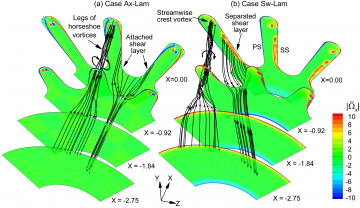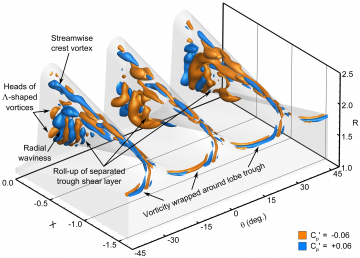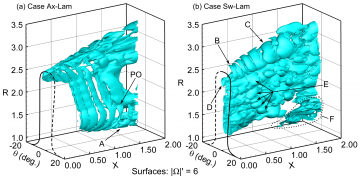Due to steadily-increasing pressure from the public and from air-traffic regulators, aircraft and engine manufacturers are aggressively researching methods for reducing the level of noise of aircraft during landing and take-off. Generally, exhaust noise reduction is achieved by mixing the high-speed exhaust stream with the lower-speed bypass stream exiting the engine. A lobed mixer enhances this mixing (thereby reducing the noise) by shaping the circular exhaust nozzle with axisymmetric lobed protuberances, referred to as a “lobed mixer”. Through a series of high-fidelity computational simulations and experiments, we identify the instabilities present in the flow and how their mutual interaction enhances the mixing process. The results are novel and represent a significant step forwards in understanding the fundamental processes occurring in a lobed mixer.
If swirl is left in the flow stream exiting the core of the engine, the swirling flow conditions may alter the mixing mechanisms of the lobed mixer. Fig. 1 illustrates swirling inflow conditions (Case Sw-Lam) results in the separation of the core flow from one side of the lobe wall. The instability and roll-up of the resulting separated shear layer has a strong impact on the mixing of the core and bypass flows downstream of the lobed-mixer discharge plane.
The roll-up of the separated shear layer in the swirling-inflow case is shown in Fig. 2 through instantaneous iso-contours of the static pressure fluctuations, which also shows that the rolled-up vortices form Lambda-shaped vortices. These Lambda-shaped vortices strongly accelerate the mixing of the core and bypass streams.
The interaction of the coherent vortical structures downstream of the discharge plane of the lobed mixer is shown in Fig. 3 through instantaneous iso-contours of the vorticity magnitude. The Lambda-shaped vortices in the swirling-inflow case induce motions that enhance the mixing of the core and bypass streams. The earlier break-down to small-scale vortices qualitatively illustrates the enhanced mixing.


